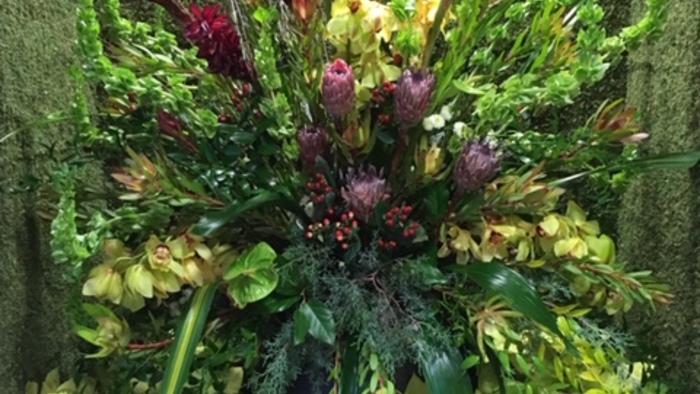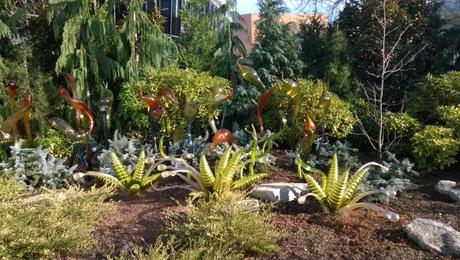The Ware Collection of Blaschka Glass Models of Plants, popularly known as the Glass Flowers at Harvard, is considered one of the university’s greatest treasures and is the only collection of its kind in the world.
The collection was compiled from 1886 until 1936 by Leopold and Rudoph Blaschka, father and son glass artists who lived and worked just outside of Dresden, Germany. Professor George Lincoln Goodale, the first director of Harvard’s Botanical Museum, wanted to create some kind of public display of plants that would be exciting but also would serve the needs of educating researchers, students, and the public.
Plants were usually preserved and displayed on herbarium specimen sheets. They would be pressed and flattened, which would distort their form and make them lose their colors. Common modeling techniques that were used during that time included wax and papier-mâché, but Goodale found both of those materials to be a little crude and not as detailed as he wanted for the permanent plant display that he envisioned.
Goodale happened to see glass models of marine invertebrates at the Museum of Comparative Zoology at Harvard. The Blaschkas had established a very successful business making these models for institutions around the world. They modeled animals that were difficult to preserve and display, including jellyfish, octopi, nudibranchs, and sea anemones.
From marine life to flowers
In 1886, Goodale traveled to Germany in the hopes of convincing the Blaschkas to make some glass models of plants for Harvard. Eventually he was able to convince them to make a few models on speculation. Two women, Elizabeth C. Ware and her daughter Mary Lee Ware, were so taken by the models that they offered to fund the production of more glass flowers.
For the next three years, the Blaschkas spent half of each year making glass models of plants and the other half of the year making models of marine invertebrates for other institutions around the world. In 1890, the Blaschkas expressed an interest in focusing on only one endeavor. Harvard negotiated a contract with them for a 10-year period, during which they would only make glass models of plants.
The collection
There are four distinct series of models in the collection. The largest depicts systematic relationships among flowering plants, another models the life cycles of cryptogams. A third series illustrates plant-insect relationships, and the last shows fruits and diseases that affect them.
This model of the salvia plant is an example from the insect pollination series. In it, you see two examples of life-sized plants as well as enlarged details. The first enlargement shows the structure of the salvia flower. The second two models show a life-sized representation as well as an enlarged detail depicting pollen being deposited on the back of an insect pollinator. The last set of models shows the life-sized version and enlarged detail of the same bee entering a flower that has matured. The stigma is now in a position to touch the back of the insect where the pollen was previously deposited. The use of life-sized models as well as enlarged details thoroughly illustrate the pollination process.
This model of a pitcher plant is one of the most spectacular models in the collection. We have similar actual specimens in the Harvard University Herbaria. By comparing the actual specimen to the glass model, one can really see the effectiveness of the glass model plants. The model was made in 1906 by Rudolph Blaschka and is quite large in size as well as extremely detailed. Comparing these later models to some of the earlier creations shows how the the Blaschkas kept challenging themselves and improving upon their technique.
The glass-working process
While the Blaschkas shared very little about their working processes and we know very little about the details of their techniques, they were adamant about stressing that they were not employing any tricks in their glass-working process. It was a unique skill set that makes their lampworking so special.
The lampworking the Blaschkas practiced was a very common glass-working technique of the time period. Glass is melted over an open flame, which is fed by air from foot-operated bellows. The glass is melted and manipulated using a variety of tools to pull, pinch, cut, and shape the glass.
The Blaschkas worked very closely together. They weren’t working on one model at a time. Rather, they would fashion many parts to many models all at once.
Most of the models have internal wire armatures to add support to the long stem structures and leaves. The Blaschkas would slide these pieces onto the wire armatures and then attach everything using either hide glue or melted glass frit.
Harvard sent the Blaschkas seeds, plant cuttings, and specimens to observe when making the models. They also had a garden that they cultivated on their property in Germany as well as access to greenhouses and botanical gardens in the Dresden area.
Tested for accuracy
The Blaschkas focused on scientific accuracy in their models, and in 1894 a botanist named Walter Dean wanted to see how accurate the models were in their finer details. Under microscopic examination and compared against his own herbarium specimens, he observed 16 models and only focused on one—this model of Aralia spinosa—in an article he wrote for the Botanical Gazette. He counted approximately 2,500 individual buds and blooms, each with their respective pistils and stamens. He also found that the details on the backside of the model, which weren’t visible on display, were just as accurate.
The last group of models that Rudolph made were of diseases that affect fruits in the Rosaceae family. This model shows a branch with apricots that show the ripe fruit through the different stages of brown rot. Another model shows the effect of apple scab.
It’s a truly incredible and singular collection, and one of Harvard’s greatest treasures. To check out what’s currently happening at the exhibit, visit hmnh.harvard.edu/glass-flowers.


















Comments
For students pursuing studies in the IT field, programming is a crucial skill to master, and Java has gained significant popularity among programmers due to its concise syntax and powerful functionality. Nowadays, there is an increasing number of students taking Java courses. https://www.lunwentop.net/java-daixie/ However, becoming proficient in Java is not an easy task. It requires students to possess strong logical thinking, grasp more complex coding structures compared to Python ghostwriting, and learn concepts such as conditional statements, loops, branches, arrays, methods, and more.
Log in or create an account to post a comment.
Sign up Log in